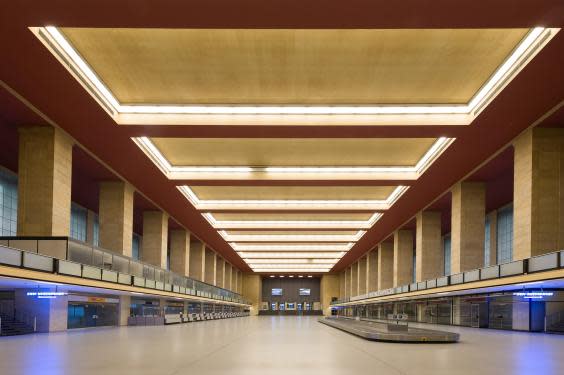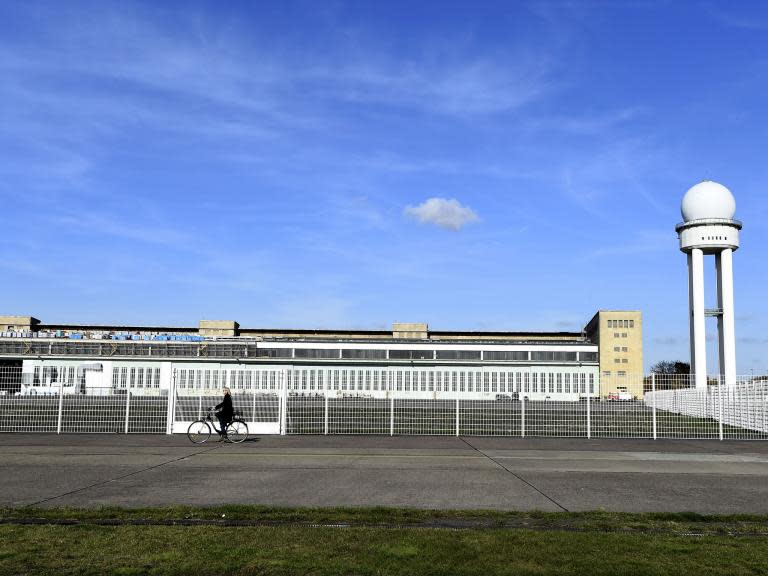The rebirth of Berlin’s Tempelhof airport
It’s been a parade ground for the Prussians and a wartime factory for the Luftwaffe, yet for many, Berlin’s Tempelhof airport remains a symbol of freedom. Just three years after the fall of the Third Reich, the Nazi-built airport became the focal point of the first major clash of the Cold War, prompting the Berlin Airlift – the largest and most daring humanitarian relief operation in history.
Today, Tempelhof is one of Europe’s largest listed buildings. After the airport closed in 2008, Berliners voted in 2014 for the 740-acre airfield in the heart of the city to be turned into a public park – much to the chagrin of developers. The lofty main terminal continues to be used for events, while in 2015 the hangars were turned into emergency shelters for around 3,000 refugees.
Now, the iconic airport is set to undergo yet another transformation. The city is investing €100m (£865) to turn Tempelhof into Berlin’s newest creative quarter – and a major tourist attraction to boot.
To explore its past and get a flavour of its future, I joined a tour of the airport, led by guide Céline Gilly.
Designed by architect Ernst Sagebiel in 1936, Tempelhof was intended to look like an eagle in flight. An arc of hangars topped by a cantilevered roof forms the bird’s wings and stretches for more than three-quarters of a mile. “The Nazis planned to have terraces on the roof for 70,000 people to watch military parades, but even with forced labour, the entire complex was never finished due to the outbreak of war in 1939,” says Gilly.
Built from limestone from southern Germany, the terminal is one of the most prominent remaining examples of Nazi-era architecture in Berlin. British bombing raids caused relatively light damage during the Second World War, although the façade is still pockmarked by bullets and window frames bear scorch marks from a fire that engulfed the building as the Red Army rolled in.
After the defeated city was divided into occupation zones by the victorious Allied powers, Tempelhof served as a US air base until 1993, with the Americans installing home comforts including a basketball court and bowling alley. Down in the subterranean cellars, the walls are still adorned with drawings of 19th century fairytales for the children who sheltered here during air raids, as well as scores scribbled by US airmen as they played pool.

Up on the curved roof, we gaze over the old airfield where thousands of locals are gathered for a kite festival, while others cycle and skate down the two mile-long runways. At the northern end of the complex, a container village housing refugees stands in the shadow of the 230ft white radio tower built by the Americans to spy on the Soviets, their former allies turned Cold War foes.
Looming on the tarmac is an old US cargo plane, a remnant of the famous airlift. In 1948, after the Soviets blockaded supply routes to West Berlin, the British, American and French allies embarked on a mission to supply some two million West Berliners exclusively by air. From June 1948 to May 1949, more than 277,000 cargo flights delivered 2.3 million tons of food and fuel that keep the city alive and saw Berliners come to view the western Allies less as occupiers and more as protectors.
At the peak of the airlift, planes took off and landed every two minutes at Tempelhof. The pilots started dropping sweets in little homemade parachutes to the children of the besieged city, earning them the nickname “candy bombers”. As part of this year’s 70th anniversary marking the end of the Berlin Airlift, around 40 of these winged workhorses will return to the skies of Berlin to drop sweets over the city on 16 June and attend air shows across the country. Now 99, Gail Halvorsen, the pilot from Utah who started the candy drops, is determined to join them. Tempelhof will also host the Berlin Airlift Festival on 12 May to coincide with the end of the airlift.

Big plans are also afoot over the next few years as Tempelhof emerges as the heart of the new Berlin Creative District. The former US Army officers’ hotel will be turned into a digital innovation centre for startups and creative businesses, while a new visitor centre is due to open in 2019 in front of the airport’s main hall.
Work will soon start on a rooftop walkway, which will feature an open-air exhibition charting Tempelhof’s turbulent history, while the renovated control tower will be accessible to visitors for the first time. Fittingly, the airport will also be home to the Allied Museum, which documents the efforts of the western Allies during the Cold War, when it relocates from the residential Dahlem district in the southwest of the city to Hangar 7 in 2020.
Berlin’s cursed new Brandenburg airport may be standing empty more than seven years after it was due to open, but the legend of Tempelhof is set to live on.
Travel essentials
Getting there
Airlines including Ryanair, easyJet, British Airways, Luthansa and Eurowings fly from the UK to Berlin from £34 return.
Visiting there
Guided tours in English are available four times a week and cost €15. To book, visit thf-berlin.de
For more information about the Berlin Airlift anniversary events, visit berlinairlift70.com



